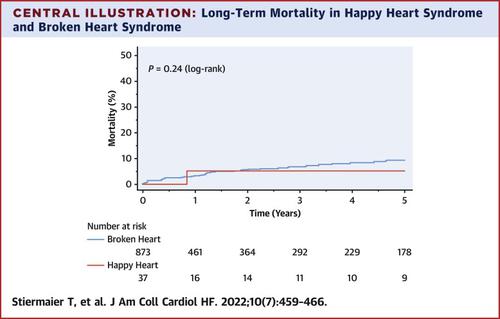JACC: Heart Failure ( IF 10.3 ) Pub Date : 2022-05-04 , DOI: 10.1016/j.jchf.2022.02.015 Thomas Stiermaier 1 , Alexandra Walliser 2 , Ibrahim El-Battrawy 3 , Toni Pätz 2 , Matthias Mezger 2 , Elias Rawish 1 , Mireia Andrés 4 , Manuel Almendro-Delia 5 , Manuel Martinez-Sellés 6 , Aitor Uribarri 7 , Alberto Pérez-Castellanos 8 , Federico Guerra 9 , Giuseppina Novo 10 , Enrica Mariano 11 , Maria Beatrice Musumeci 12 , Luca Arcari 13 , Luca Cacciotti 13 , Roberta Montisci 14 , Ibrahim Akin 3 , Holger Thiele 15 , Natale Daniele Brunetti 16 , Ivan J Núñez-Gil 17 , Francesco Santoro 16 , Ingo Eitel 1

|
Background
The association with a preceding stressor is a characteristic feature of takotsubo syndrome (TTS). Negative emotions before TTS are common and led to the popular term “broken heart syndrome.” In contrast, pleasant triggers (“happy heart syndrome”) are rare and are scarcely investigated.
Objectives
The authors analyzed the frequency, clinical characteristics, and prognostic implications of positive emotional stressors in the multicenter GEIST (GErman-Italian-Spanish Takotsubo) Registry.
Methods
Patients enrolled in the registry were categorized according to their stressors. This analysis compared patients with pleasant emotional events with patients with negative emotional events.
Results
Of 2,482 patients in the registry, 910 patients (36.7%) exhibited an emotional trigger consisting of 873 “broken hearts” (95.9%) and 37 “happy hearts” (4.1%). Consequently, the prevalence of pleasant emotional triggers was 1.5% of all TTS cases. Compared with patients with TTS with negative preceding events, patients with happy heart syndrome were more frequently male (18.9% vs 5.0%; P < 0.01) and had a higher prevalence of atypical ballooning patterns (27.0% vs 12.5%; P = 0.01), particularly midventricular ballooning. In-hospital complications, including death, pulmonary edema, cardiogenic shock, or stroke (8.1% vs 12.3%; P = 0.45), and long-term mortality rates (2.7% vs 8.8%; P = 0.20) were similar in “happy hearts” and “broken hearts.”
Conclusions
Happy heart syndrome is a rare type of TTS characterized by a higher prevalence of male patients and atypical, nonapical ballooning compared with patients with negative emotional stressors. Despite similar short- and long-term outcomes in our study, additional data are needed to explore whether numerically lower event rates in “happy hearts” would be statistically significant in a larger sample size. (GErman-Italian-Spanish Takotsubo Registry [GEIST Registry]; NCT04361994)
中文翻译:

开心综合症
背景
与前一个压力源的关联是章鱼坪综合征 (TTS) 的一个特征。TTS 之前的负面情绪很常见,并导致了流行的术语“心碎综合症”。相比之下,愉快的诱因(“快乐的心脏综合症”)很少见,也很少被研究。
目标
作者在多中心 GEIST(德国-意大利-西班牙 Takotsubo)登记处分析了积极情绪压力源的频率、临床特征和预后影响。
方法
注册登记的患者根据他们的压力源进行分类。该分析比较了有愉快情绪事件的患者和有负面情绪事件的患者。
结果
在登记的 2,482 名患者中,910 名患者 (36.7%) 表现出情绪触发因素,包括 873 颗“破碎的心”(95.9%) 和 37 颗“快乐的心”(4.1%)。因此,愉快的情绪触发因素占所有 TTS 案例的 1.5%。与有负面先兆事件的 TTS 患者相比,快乐心综合征患者更常为男性(18.9% 对 5.0%;P < 0.01)并且非典型气球样变的患病率更高(27.0% 对 12.5%;P = 0.01) ,特别是心室中部气球样变。院内并发症,包括死亡、肺水肿、心源性休克或中风(8.1% 对 12.3%;P = 0.45)和长期死亡率(2.7% 对 8.8%;P =0.20)在“快乐的心”和“破碎的心”中相似。
结论
快乐心脏综合征是一种罕见的 TTS 类型,其特征是与具有负面情绪压力源的患者相比,男性患者和非典型非心尖气球样变的患病率更高。尽管在我们的研究中有类似的短期和长期结果,但还需要更多数据来探索“快乐的心”中事件发生率在数值上较低是否在更大的样本量中具有统计学意义。(德国-意大利-西班牙 Takotsubo 注册表 [GEIST 注册表];NCT04361994)











































 京公网安备 11010802027423号
京公网安备 11010802027423号